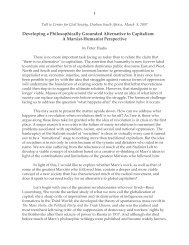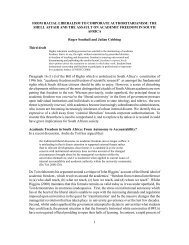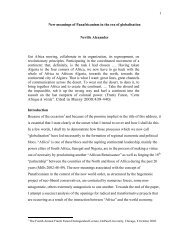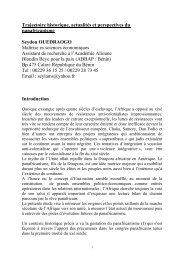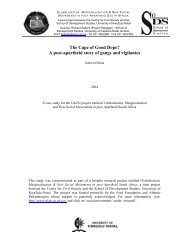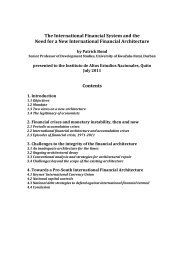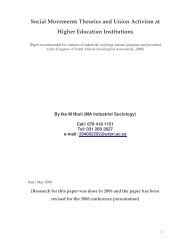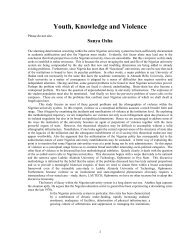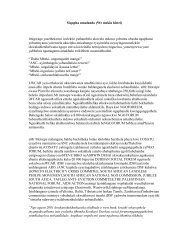April 2011 - Centre for Civil Society - University of KwaZulu-Natal
April 2011 - Centre for Civil Society - University of KwaZulu-Natal
April 2011 - Centre for Civil Society - University of KwaZulu-Natal
You also want an ePaper? Increase the reach of your titles
YUMPU automatically turns print PDFs into web optimized ePapers that Google loves.
efining and Karoo gas-fracking are approved; and shipping will also carry a<br />
carbon tax on pollution-intensive bunker fuels.<br />
As <strong>for</strong> the celebrated new ‘green’ industries, the only IPAP2 strategy that<br />
earns climate mitigation brownie points is the urgent replacement <strong>of</strong><br />
electric hot water heaters with solar-powered versions. Yet because<br />
Pretoria gave Eskom this responsibility, a tiny fraction <strong>of</strong> the promised<br />
output has been delivered. And Eskom celebrated its new loan last week<br />
by cutting its subsidy <strong>for</strong> consumers installing the solar heaters.<br />
Other components <strong>of</strong> Davies’ Green Economy and agro-processing strategy<br />
are so bound up in bi<strong>of</strong>uel, genetic engineering and land grab<br />
controversies, that they stand with IPAP’s hopes <strong>for</strong> <strong>for</strong>estry (also subject<br />
to growing eco-social criticisms) and nuclear energy (!) as still-born or<br />
dinosaur industries, typically described as ‘false solutions’ to climate<br />
crisis.<br />
The macroeconomic ceiling<br />
If these dilemmas represent a green wall beyond which IPAP cannot<br />
proceed, they pail in comparison to the macro dilemma: Davies wants to<br />
hit the manufacturing accelerator, but the Treasury and Reserve Bank<br />
have their foot on the fiscal and monetary brakes.<br />
In his 2010 parliamentary testimony, Davies gave several reasons why “the<br />
pr<strong>of</strong>itability <strong>of</strong> manufacturing has been low”, including the currency, “the<br />
high cost <strong>of</strong> capital” (indeed SA’s interest rate remains very high even<br />
after the 2009-10 reductions), “monopolistic provision and pricing <strong>of</strong> key<br />
inputs”, “unreliable and expensive infrastructure”, “a weak skills system”,<br />
and “failure to leverage public expenditure” into industrial growth.<br />
Davies named the three most serious “negative, unintended consequences<br />
<strong>of</strong> this growth path: unsustainable imbalances in the economy, continued<br />
high levels <strong>of</strong> unemployment and a large current account deficit.”<br />
Moreover, although SA witnessed impressive GDP growth during the 2000s,<br />
this does not take into account the depletion <strong>of</strong> non-renewable resources -<br />
if this factor plus pollution were considered, SA would have a net negative<br />
per person rate <strong>of</strong> national wealth accumulation (<strong>of</strong> at least US$ 2 per<br />
year), according to even the World Bank’s 2006 book Where is the Wealth<br />
<strong>of</strong> Nations?<br />
SA’s economy became much more oriented to pr<strong>of</strong>it-taking from financial<br />
markets than production <strong>of</strong> real products, in part because <strong>of</strong> extremely<br />
high real interest rates, especially from 1995-2002 and 2006-09. The two<br />
most successful major sectors from during this era were communications<br />
(12.2 per cent growth per year) and finance (7.6 per cent) while labourintensive<br />
sectors such as textiles, footwear and gold mining shrunk by<br />
beween 1 and 5 per cent per year, and overall, manufacturing as a<br />
percentage <strong>of</strong> GDP also declined.<br />
Other imbalances include the Gini coefficient measuring inequality rose<br />
during the post-apartheid period, with the Institute <strong>for</strong> Democracy in South<br />
Africa measuring the increase from 0.56 in 1995 to 0.73 in 2006. According<br />
to Haroon Bhorat’s 2009 study, black households lost 1.8% <strong>of</strong> their income<br />
from 1995-2005, while white households gained 40.5%. Unemployment<br />
doubled to a rate <strong>of</strong> around 40% at peak, if those who have given up<br />
looking <strong>for</strong> work are counted, and around 25% otherwise.<br />
Moreover, most <strong>of</strong> the largest Johannesburg Stock Exchange firms – Anglo<br />
American, DeBeers, Old Mutual, Investec, SA Breweries, Liberty Life,<br />
Gencor (now the core <strong>of</strong> BHP Billiton), Didata, Mondi and others – shifted



